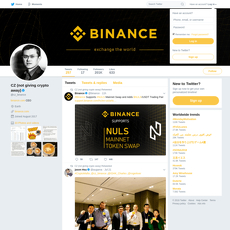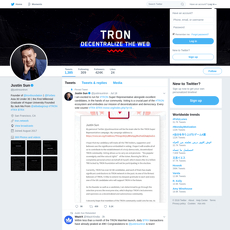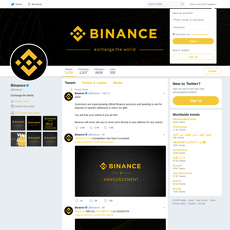Nejc Kodrič Review
Nejc Kodrič
twitter.com
Nejc Kodrič Twitter Review Guide: Everything You Need to Know (with FAQ)
Can following one crypto founder on X actually make you smarter—and safer? If you’ve ever wondered whether a steady operator like Nejc Kodrič is worth a spot on your feed, you’re exactly where you need to be.
I’m looking at Nejc—the co-founder of Bitstamp and long-time crypto builder—to help you decide fast. No fluff, no hero worship, just a clear way to read his posts and use them to your advantage.
Describe problems or pain
Crypto Twitter can feel like a firehose. You know there’s signal in there somewhere, but:
- You don’t have time to fact-check every thread or chart.
- It’s hard to tell who’s credible and who’s farming engagement.
- Regulatory takes get mixed with rumors—often without links or timestamps.
- “Hot” calls crowd out practical insights you can actually use.
Real talk: misinformation moves fast. A well-known Science study from MIT showed false news can spread faster than truth on social platforms. Pair that with the fact that many people now get at least some news from social media (see Pew Research), and you’ve got a recipe for confusion if you follow the wrong voices—or the right voices the wrong way.
“Follow the person, but also follow their process.”
With founders and operators like Nejc, it’s not about chasing every post. It’s about understanding why they say what they say, when they say it, and how that maps to your decisions.
Promise solution
Here’s the plan: I’ll break down who Nejc is, why people pay attention to him, and how to read his posts without wasting time. I’ll point out what’s useful (and what’s not), and I’ll answer the questions I keep hearing so you can decide in minutes if he’s worth your follow.
By the end, you’ll have a simple way to scan his timeline, spot the signal, and turn it into smarter moves—whether you’re a retail user, a builder, or somewhere in between.
Why listen to me?
- Years spent testing exchanges, tools, and thought leaders—across bull and bear cycles.
- Bias toward practicality, security, and real user outcomes—not hype.
- A repeatable review framework that filters claims through track record, incentives, and evidence.
I don’t care about follower counts. I care about whether someone helps you avoid mistakes and make better choices.
What you’ll get from this review
- A simple framework for reading Nejc’s posts on X without getting lost.
- A balanced take on strengths and limits—what he does well, and where to be cautious.
- Quick FAQs based on what people actually ask (clear, short answers you can verify).
- Practical resources you can bookmark so you don’t have to chase context later.
If you’ve been burned by loud voices or vague claims, you’ll appreciate a calmer, operator-grade lens. And if you’re here for constant trade calls or meme momentum, that’s not what you’ll find—by design.
So, who is Nejc, what’s his background, and why does that matter for your feed? Let’s answer that next—starting with a quick snapshot you can trust.
Who is Nejc Kodrič? A quick snapshot
Nejc Kodrič is best known as the co-founder and former CEO of Bitstamp, one of crypto’s longest-running exchanges. He’s an operator-turned-investor who usually keeps things measured: think market structure, regulation, exchange reliability, and long-game product building—less noise, more signal. If you’re sizing him up on X/Twitter, here’s his profile: @nejc_kodric.
“In crypto, uptime and trust beat hype over the long run.”
Brief timeline and roles
- 2011: Co-founds Bitstamp with Damijan Merlak as a lean, Europe-based alternative to Mt. Gox. Early focus: reliability, fiat rails, and clean compliance basics.
- 2015: Bitstamp suffers a security incident (~19,000 BTC). Operations pause, hot wallets are rebuilt, and security is overhauled before reopening—an early case study in transparent comms and operational recovery.
- 2016: Bitstamp secures a Payment Institution license in Luxembourg, enabling EU passporting—a big step for compliant exchange operations across Europe. Bitstamp announcement
- 2018: Majority acquisition by NXMH (affiliated with NXC), with Nejc staying on as CEO and shareholder. The focus remains on stability, banking relationships, and scale. Reuters
- 2020: Transitions from CEO into a board/advisory capacity as Bitstamp brings in new leadership to keep scaling in tighter regulatory environments.
- 2021–present: Focuses on investing and advising in crypto/fintech infrastructure, compliance-forward products, and market plumbing—reflected in his postings and the kind of projects he engages with on X and in the background.
That arc—bootstrapping an exchange, navigating real crises, winning licenses, and steering through an acquisition—shapes the way he writes. You’ll notice a bias toward operational reality over speculation.
What I look for when I review a crypto figure
- Consistency: Is the tone measured over time? Does advice whiplash with price? Nejc tends to keep a steady cadence and avoids heat-of-the-moment hot takes.
- Accuracy and sourcing: Are claims backed by links, filings, or first-hand experience? When he talks regulation (e.g., EU MiCA), he usually frames operational impact—passporting, capital, custody—rather than just headlines.
- Skin in the game: Years running a licensed exchange through multiple cycles is real exposure. That shows up in commentary on liquidity, banking rails, and incident response.
- Transparency: I look for clear boundaries: what he knows first-hand versus what he’s observing. Historical moments like Bitstamp’s 2015 rebuild are part of that trust basis.
- User value: Does the content make people safer or smarter? His posts skew toward reducing operational risk and understanding how exchanges actually work.
If you’ve ever felt lost in theoretical takes about regulation, this filter helps. Posts that explain trade-offs—like custody segregation or the limits of “proof of reserves” without audits—are the ones I bookmark.
Why his perspective matters
Running a regulated exchange for years changes your instincts. It forces a focus on the stuff that breaks first when markets get rough: fiat rails, custody flows, order book quality, and support queues. That experience translates into three areas I find especially useful:
- Market structure clarity: He understands how liquidity actually moves—between spot, derivatives, and fiat—and why uptime and stable APIs matter more than shiny features.
- Regulation with real-world constraints: Licenses aren’t press releases; they’re capital and processes. Expect commentary grounded in KYC/AML requirements, passporting timelines, and banking relationships that exchanges must protect to survive.
- User protection by design: Cold storage discipline, incident response, and comms protocols aren’t glamorous, but they’re what keep users whole. When he posts about risk, it’s typically “here’s how to not blow up,” not “here’s the next 100x.”
There’s a reason regulated exchanges tend to attract more institutional flow over time: predictable operations and clearer accountability. If you care about staying power, that lens is gold.
Curious how those instincts were forged—through hacks, licensing, acquisitions, and market chaos? The next part breaks down the Bitstamp era and the lessons that still show up between the lines on @nejc_kodric’s timeline. What did those years teach about trust, regulation-first thinking, and user safety—without slowing innovation?
The Bitstamp era: trust, regulation-first thinking, and lessons
Some founders talk about safety. Others have lived through the kind of moments that force it into their DNA. Bitstamp’s run across bull and bear cycles shaped a real operating philosophy—one I keep seeing reflected in how Nejc thinks, posts, and invests today.
“Trust is built in calm days and tested in storms.”
Here’s what matters from that era and why it’s a useful lens for anyone trying to separate signal from noise.
Milestones worth noting
- 2011 – Early exchange play with real fiat rails: Launching when Mt. Gox still dominated took courage and focus. Getting SEPA support and banking partners in Europe signaled a long-game approach to compliance and payments.
- 2015 – The hard lesson (and the recovery): A hot-wallet breach saw ~19,000 BTC stolen. Bitstamp froze operations, rebuilt its stack, came back online, and made customers whole. That response—halt, fix, communicate, reimburse—set a standard many later failed to meet. Source: CoinDesk coverage.
- 2015–2016 – Multi-sig and licensing: Post-incident, Bitstamp adopted BitGo multi-signature wallets and secured a payment institution license in Luxembourg, enabling EU passporting—one of the earliest nationally regulated exchange setups in Europe (Bitstamp announcement).
- 2018 – Institutional backing and governance: Majority acquisition by Belgium-based NXMH, providing capital and corporate structure for the next phase (Reuters).
- 2019 – New York BitLicense: Not a trophy so much as an ongoing commitment to audits, reporting, and controls. Check the regulator’s list here: NYDFS Virtual Currency Businesses.
- 2023 – Choosing caution in the U.S.: Suspending trading for a set of tokens after SEC designations and winding down staking for U.S. users showed the same playbook: protect licenses, keep banking, keep users safe.
Why do these matter? Because longevity in crypto exchanges is statistically rare. One peer-reviewed study examined early exchanges and found a high failure rate, with many disappearing without returning funds (Moore & Christin, 2013). Bitstamp’s ability to survive a breach, earn licenses, and maintain fiat access signals operational discipline—not just good PR.
Security and compliance mindset
When I look at Nejc’s posts through the Bitstamp lens, I see an operator who defaulted to user protection first and carried that forward.
- Incident response over image management: The 2015 response wasn’t lightning-fast marketing; it was controlled triage: pause, isolate, harden, reimburse. That shows up today as a calm reaction style to market panics—less “hot take,” more “what’s the process?”
- Defense-in-depth thinking: Moving to multi-sig custody with a specialist was early “don’t build everything yourself” wisdom—delegating to audited, purpose-built providers. It’s the kind of trade-off builders still struggle with.
- Licenses as a feature, not a drag: Licensing unlocked bank rails and institutional trust. Empirically, illicit flows concentrate in poorly controlled venues—compliance-first exchanges handle a tiny share of them (Chainalysis 2023). That matters for users who want deposits and withdrawals to work every time.
- Conservative listings = fewer landmines: Bitstamp historically listed fewer, more established assets versus hyper-growth exchanges. You trade “what’s hot today” for “what’s still here next year.” That bias is visible in Nejc’s tone: risk-adjusted returns over novelty.
- Regulatory realism: Pausing products in uncertain jurisdictions wasn’t capitulation; it preserved core services. It’s a lesson many DeFi-to-exchange efforts learned the hard way.
If you’ve ever been burned by an exchange freezing your funds or changing terms overnight, this mindset resonates. It’s not flashy. It’s how people keep their money.
How this shapes my rating
Operating a regulated exchange through chaos leaves fingerprints on a person’s worldview. Here’s how that background influences how I score his signal:
- Trust & credibility: High. Running a platform that reimbursed users after a breach and then earned EU and NY approvals indicates a real tolerance for scrutiny and controls.
- Risk framing: Cautious by design. Great for users who want to avoid blowups; less exciting if you crave edge-case speculation.
- Actionability for builders: Strong. If you’re building custody, fiat rails, or compliant products, this lens will save you time and pain.
- Coverage breadth: Narrower on experimental narratives; deeper on market structure, liquidity, and regulation.
I read his posts expecting clear guardrails more than adrenaline. When he nods at a theme—licensing progress, custody standards, liquidity quality—it tends to be grounded in operating reality, not vibes.
So how do you actually turn that into value when you scroll his timeline? What signals are worth your bookmarks—and what should trigger a quick fact-check before you act? Let’s look at that next and make your feed smarter in minutes.
Reading his Twitter: what signals to watch on @nejc_kodric
When I scan Nejc Kodrič’s timeline, I don’t ask “Do I agree?” first. I ask “What can I use?” The difference matters. Here’s how I read his posts quickly and squeeze signal from the noise.
“Clarity beats hype, every time.”
Types of posts you’ll see
His feed isn’t a meme machine. It’s usually operator-grade notes with links and context. Expect:
- Market structure and liquidity: Takes on how books behave, fees, spreads, and why stable rails matter. You’ll often see context first, opinions second.
- Regulation and policy: Think EU-first lens. If there’s a new framework (like MiCA), he’ll point toward primary text rather than hot takes. Example of the kind of source he’d reference: MiCA in the Official Journal.
- Exchange operations: Notes on custody, uptime, incident response, and why boring processes keep users safe. Less “number go up,” more “systems don’t break.”
- Investor lens: Occasionally, portfolio or sector-level comments. It’s measured—expect frameworks, not calls.
Quick scan trick I use:
- Filter posts with links: On X, use from:@nejc_kodric filter:links to see source-backed content fast.
- Find topic clusters: Use from:@nejc_kodric MiCA, from:@nejc_kodric ETF, or from:@nejc_kodric liquidity to map recurring themes.
Engagement patterns and context
Who someone responds to and what they amplify is part of the story.
- Replies signal respect: Watch replies to regulators, founders, market-structure researchers, and long-running operators. That’s where nuance shows up.
- Amplification tells you priorities: If he retweets a thread linking to an SEC filing, an EU memo, or an exchange incident report, assume it’s worth bookmarking.
- Silence can be a signal: During rumor cycles, if he stays quiet, consider that a nudge to wait for facts. This lines up with what we know from research: false news tends to spread faster than truth—novelty drives retweets. A well-cited study in Science found exactly that (Vosoughi et al., 2018).
How I decode the context quickly:
- Check the timestamp: Is he posting before official releases or after the docs drop? If it’s after, expect more accuracy and less guessing.
- Follow the link trail: A post that points to primary sources beats a screenshot of someone else’s screenshot.
Green flags vs red flags
- Green flags you’ll often get from him:
- Clarity over drama: Short claims, references, and what it means for users.
- Sources: Official docs (EU law, regulator sites), not just threads.
- Real-world constraints: Notes on licensing, custody, audits, and liquidity—things that actually limit or enable products.
- Red flags to watch anywhere on crypto Twitter (apply this filter broadly):
- Vague claims with no link: “Hearing big news soon.” Okay… from where?
- No timestamps/screenshots only: Old charts get recycled. Always click through.
- Cherry-picked charts: Zoomed-in ranges or truncated axes can mislead. If a chart looks dramatic, look for the full series.
One more research-backed reminder: engagement isn’t accuracy. That Science study showed the most viral items aren’t usually the truest. So when a post is calm and sourced, that’s a feature, not a bug.
How to use his insights without getting lost
I turn his feed into action with a simple workflow:
- 30-second read: What’s the claim? What’s the link? What changes for users or builders?
- Bookmark by theme: Create X/Twitter bookmarks folders like Regulation, Market Structure, Security. His posts fit neatly into these.
- Fact-check the big ones: If a post could affect money or ops, open the source and skim the actual document (EU regs, SEC pages, exchange status pages).
- Wait when needed: If he comments on a developing story without firm documents yet, tag it “watch” and revisit in 24–48 hours.
- Pair with a counter-lens: For balance, follow one technical researcher and one policy analyst. Contrast sober ops talk with builders pushing speed—truth lives in the middle.
Practical shortcuts I actually use:
- Mute retweets for a week to see only his voice, then re-enable if you miss useful signals.
- Subscribe to alerts only for posts with links using advanced search saved as a bookmark: https://twitter.com/search?q=from%3Anejc_kodric%20filter%3Alinks&src=typed_query
- Keep a running note of recurring concepts (custody segregation, proof-of-reserves methods, EU licensing). Patterns teach faster than one-off hot takes.
Emotion check when you read any crypto feed (including his):
- If a post makes you feel rushed—slow down and look for the source.
- If a post feels boring but sourced—that’s often where the money-saving insight hides.
Signal isn’t loud. It’s consistent. Now, if you’re wondering how all this translates into strengths, limits, and a few myths people repeat about Nejc—even seasoned folks get some of these wrong—want the short version next?
Pros, cons, and common myths about Nejc Kodrič
Strengths I value
Some people speak from the sidelines. He speaks like someone who’s felt the weight of customer funds, regulators, and uptime on their shoulders. That matters. Here’s what consistently stands out:
- Operator-level clarity: You get posts shaped by years of exchange-building—how liquidity actually moves, why custody choices matter, and what real risk control looks like when things break.
- Regulation that enables, not paralyzes: Picking an EU license early (Bitstamp’s Luxembourg approval in 2016) wasn’t trendy—it was durable. It set the tone for how he sees sustainable growth: ship within rules, scale without drama. Source: Bitstamp is regulated in Luxembourg.
- User-safety reflexes: When exchanges face incidents, the real test is how they respond: freeze risk, communicate, upgrade custody, restore trust. His stance consistently favors that sequence over quick PR wins.
- No hype, more signal: Posts tend to be measured and about market structure, not price calls. That’s refreshing—and useful when the timeline is on fire.
- Skin in the game: Years of stewarding an exchange through multiple cycles sharpen your BS filter. You can feel that in the way he talks about liquidity, compliance, and long-term customers.
“In crypto, patience isn’t passive—it’s protective.”
Limitations and biases to keep in mind
Nobody’s lens is perfect. Here’s where his angle may not fit everyone:
- Regulation-first bias: If you live on the bleeding edge of DeFi or meme-driven momentum, the caution can feel slow or conservative.
- Low-frequency posting: Fewer threads means fewer instant takes during fast news cycles. If you want play-by-play commentary, you’ll need to pair him with higher-velocity accounts.
- Less about altcoin narratives: You won’t get deep dives on every new token. The focus is infrastructure, custody, compliance, and user protection.
- Preference for evidence: He tends to wait for facts before weighing in. Great for accuracy, not ideal if you thrive on early speculation.
Myths I still hear—and what the data suggests
Myth: “He’s anti-innovation because he talks regulation.”
Reality: Regulation done right is a force multiplier. The longest-running venues are often the ones that invested early in compliance, security, and banking rails. That’s not anti-innovation; it’s the plumbing that keeps innovation alive when markets get rough.
Myth: “Low posting = low value.”
Reality: Signal often beats speed. Research from MIT found false news spreads faster than truth on Twitter/X—velocity isn’t the same as accuracy. Source: MIT study on false news. A low-noise feed can help you think, not react.
Myth: “Talking risk is fear-mongering.”
Reality: It’s responsibility. In 2022 alone, attackers stole an estimated $3.8B from crypto platforms, mostly in DeFi exploits—risk management isn’t optional. Source: Chainalysis: 2022 crypto hacking.
Myth: “He shills coins.”
Reality: His feed is light on token cheerleading and heavy on market plumbing: custody, liquidity, regulation, and exchange operations. If you want pure price calls, this won’t scratch that itch—and that’s the point.
Who benefits most from following him
Ask yourself what you want from your feed. If it’s signal you can act on without taking on blind risk, here’s where he fits:
- Security-first newcomers: If you’re building a safe foundation—wallet setup, exchange selection, custody basics—his lens helps you avoid avoidable mistakes.
- Builders and operators: If you’re working on exchanges, wallets, payments, infra, or compliance, his posts offer reality checks you can take straight into sprint planning.
- Long-horizon investors: If you care about market structure, regulation timelines, and counterparty risk more than weekly charts, you’ll get steady context.
- Who won’t love it: High-frequency traders hunting constant setups, and meme-chasers needing hourly narratives.
Quick personal takeaway: I’d rather have one post that upgrades my mental model than ten that boost my dopamine. If you feel the same, he’s probably worth the follow.
Curious how to quickly test any crypto voice for credibility—mine included? In the next section, I’ll share a 5-step checklist and rapid-fire FAQs you can scan in under a minute.
FAQs and practical resources
FAQs people ask (and quick answers)
I pulled the questions I hear the most, then kept the answers short and source-able. When in doubt, check primary links and save the rest for later.
Is Nejc Kodrič still involved with Bitstamp?
Short answer: He co-founded Bitstamp and later moved away from day‑to‑day leadership. For official history and leadership changes, check Bitstamp’s site and news archives:
- Bitstamp official site
- Bitstamp blog (use site search for “CEO” or “leadership”)
- Reuters coverage of Bitstamp’s 2018 acquisition
What does he usually post about on X/Twitter?
Market structure, regulation, exchange operations, and steady commentary on how crypto infrastructure should work. Not a trade-signal feed. See for yourself: @nejc_kodric.
Is he biased toward regulation?
Yes—his background running a long-standing exchange shows. That bias is useful if you care about security, compliance, and longevity; less useful if you only want aggressive degen plays.
Can I fact-check his claims?
Usually. He tends to reference public info (laws, licenses, operational best practices). Cross-check with primary sources like regulator pages, official exchange announcements, and reliable news. See the resource list below.
Does he post trading calls?
Rarely. Expect measured takes, not “buy now” charts.
How often does he post?
Not high volume. That’s a feature, not a bug—signal over noise.
Is Bitstamp actually regulated in the EU?
Bitstamp Europe S.A. has been supervised in Luxembourg. For the latest, use Bitstamp’s regulatory/legal page and look up the relevant register via the official regulator:
- Bitstamp Legal
- CSSF supervision portal (Luxembourg)
Search for “Bitstamp Europe S.A.” on the regulator’s site for the current status.
Why should I trust a founder’s Twitter in the first place?
You shouldn’t, blindly. Social media is efficient but noisy. A well-cited study found false news spreads faster than truth on Twitter (Science, 2018). Use posts as leads, not final answers.
Pro tip: Use X’s Advanced Search to find context fast. Try queries like: from:nejc_kodric regulation or from:nejc_kodric Bitstamp. Link: twitter.com/search-advanced
How I review people in crypto (my simple framework)
I use the same filter every time so I don’t get spun by narratives. You can copy this for anyone you follow:
Identity & track record: Real name, verifiable history, and third‑party coverage?
- Example: Nejc’s role at Bitstamp is backed by years of press and company records. Cross-check: Bitstamp blog, Reuters company coverage.
Incentives: What do they stand to gain? Are they promoting a token, an exchange, or a fund? If incentives are clear, you can adjust your trust dial appropriately.
Claims vs. evidence: Do posts include sources, data, or time-stamped facts? If not, can you independently verify? No source = “park it” until you find one.
Risk awareness: Do they address trade-offs, not just upside? Mature operators talk in constraints: custody risks, liquidity, compliance timelines, counterparty dependencies.
User value: After reading 10 posts, did you learn something actionable? If the answer is “meh,” unfollow.
Why this works: It protects you from charisma. A clean checklist beats gut feel, especially when markets are loud.
Useful resources to keep handy
Bookmark these so you can verify claims in under a minute.
Primary accounts:
- Nejc’s X/Twitter: @nejc_kodric
- Bitstamp site: bitstamp.net
- Bitstamp blog/announcements: bitstamp.net/blog
Regulation & policy:
- EU MiCA full text (official): eur-lex.europa.eu
- Luxembourg regulator (CSSF) supervision portal: cssf.lu/en/supervision
Market structure and on-chain context:
- Glassnode (metrics to sanity-check claims): glassnode.com
- Kaiko (market data and liquidity research): kaiko.com
Verification helpers:
- X Advanced Search: twitter.com/search-advanced
- Wayback Machine (see what a page said last year): web.archive.org
Research on information quality:
- False news spread study (Science, 2018): science.org
How to use this fast: When you see a claim on X, ask: “Is there a primary link?” If not, hit the regulator page, company blog, or Wayback. 90 seconds is enough to avoid most bad takes.
Should you follow him? A quick decision guide
Follow if: you want steady operator-grade insights on exchanges, regulation, and risk. You prefer fewer, higher-signal posts you can actually act on.
Maybe skip if: you want constant trade calls, meme-fueled momentum, or daily price commentary.
Want to turn his posts into real edge without spending hours online? I’ll show the exact alert setup, who to pair him with for balance, and how to build a feed that makes you smarter in under 10 minutes a week—ready for that?
Next steps: make his insights work for you
Build a smarter feed
Here’s the simple setup I use so I learn faster without getting flooded by noise.
- Follow smart, alert sparingly: Follow @nejc_kodric. Turn on notifications for “Tweets” only (not “Replies”) so you catch his bigger posts without ping overload.
- Create a tight “Market Structure + Reg” List: Put him alongside one on-chain data source, one policy/reg account, and one market microstructure voice. Keep it under 10 accounts so it stays focused. I use it when I want signal, not chatter.
- Use saved searches to surface his most useful posts: In X’s search, save:
- from:nejc_kodric regulation OR MiCA OR custody OR liquidity
- from:nejc_kodric exchange OR market OR compliance
These make it easy to scan higher-value takes when you’ve got five minutes. - Bookmark threads the right way: When he posts an explainer on market structure or regulation, bookmark it and add a note like “Reg/MiCA” or “Ops/Liquidity.” Once a week, export bookmarks to your notes app and tag them. You’ll build a mini playbook fast.
- Pair with a contrasting lens: Add one DeFi researcher, one compliance lawyer, and one liquidity/market maker account to balance viewpoints. The point isn’t to agree—it’s to spot blind spots early.
- Mute words that waste your time: Add filters like “gm,” “airdrop when,” and random ticker spam. Your brain will thank you.
- Automate a safety net: Use IFTTT or Zapier to push his tweets containing “MiCA,” “custody,” or “liquidity” to a Notion/Google Doc. It builds a searchable knowledge base as you go.
“Trust, but verify” beats “scroll, then react.”
False or oversimplified claims spread faster than truth on social platforms—MIT’s landmark study found false news was ~70% more likely to be retweeted than true stories. Use that as your reminder to validate before acting.
Source: Science (Vosoughi, Roy, Aral, 2018)
For builders and advanced users
Here’s how I turn operator-grade insights into real product and trading advantages.
- Custody: assume failure points upfront.
- Action: Map your key flows (deposits, withdrawals, hot/cold transitions). Add enforced withdrawal delays, spend limits, and 4-eyes approval on high-risk moves.
- Standards to cross-check: CCSS and ISO 27001. If your stack ignores these, fix that before you ship features.
- Tech posture: Prefer MPC or HSM-based custody with audit trails. Run quarterly key-ceremony drills. Document everything.
- Compliance: reduce “unknown unknowns.”
- Action: For any policy post he makes, pin it to a checklist: What jurisdiction? What asset category? What immediate risk (listing, marketing, custody, segregation)?
- Primary sources: MiCA (EU 2023/1114), SEC, FCA, and your local regulator. If your legal read disagrees with a viral thread, your legal read wins.
- Practical example: If he flags stablecoin rules, audit your EMT/ART exposure and marketing language the same week. Don’t wait for “final guidance” to start cleanup.
- Liquidity: build for stress, not sunshine.
- Action: Track spread, slippage, and depth by venue and pair. Kill vanity volume; optimize for quality flow and uptime.
- Data to use: Kaiko or Coin Metrics for order book and volume quality. Watch volatility windows after macro prints—your users feel those spreads.
- Market maker agreements: Include minimum quote obligations, circuit-break behavior, and clear offboarding rules. Backtest with worst-day data, not averages.
- Run real tabletop scenarios, not thought experiments.
- Outage drill: Freeze withdrawals on a testnet or staging mirror. Measure Recovery Time Objective and comms speed.
- Banking-rail drill: Lose your top PSP in the scenario. Can you reroute EUR/USD flows within 24 hours? Test it.
- Incident response: Prewrite user updates and regulator notifications. Use NIST 800-61 as your baseline.
- Proof you’re serious: plan PoR before you need it.
- Action: Commit publicly to a cadence (e.g., quarterly) and methodology (Merkle + independent auditor; include liabilities). Don’t wait for pressure to mount.
- Trader tip: Never trade on a single post.
- Wait for a second source or a primary document. If it’s a regulatory item, read the PDF. If it’s market structure, check order books. Give it 24 hours unless there’s a clear, document-backed catalyst.
Small, real example of the workflow I use:
- He posts about liquidity fragmentation in EUR pairs.
- I check live spreads across two venues and a DEX aggregator, then snapshot depth at 1% for the top three EUR pairs.
- If I see persistent gaps, I adjust routing rules or alert my MM to widen/adjust quotes where needed.
- Result: fewer surprise fills, happier power users.
Conclusion
There’s a rare steadiness in operator-led commentary. It’s not the loudest, but it ages well. Use it as your baseline, then stress-test with your own data and sources. If you value credibility and want fewer unforced errors, he’s worth your follow—just keep your filters on and verify anything that could cost you money or reputation.
I’ll keep sharing practical pieces like this on cryptolinks.com so you can stay sharp without getting lost in takes.
CryptoLinks.com does not endorse, promote, or associate with Twitter accounts that offer or imply unrealistic returns through potentially unethical practices. Our mission remains to guide the community toward safe, informed, and ethical participation in the cryptocurrency space. We urge our readers and the wider crypto community to remain vigilant, to conduct thorough research, and to always consider the broader implications of their investment choices.













